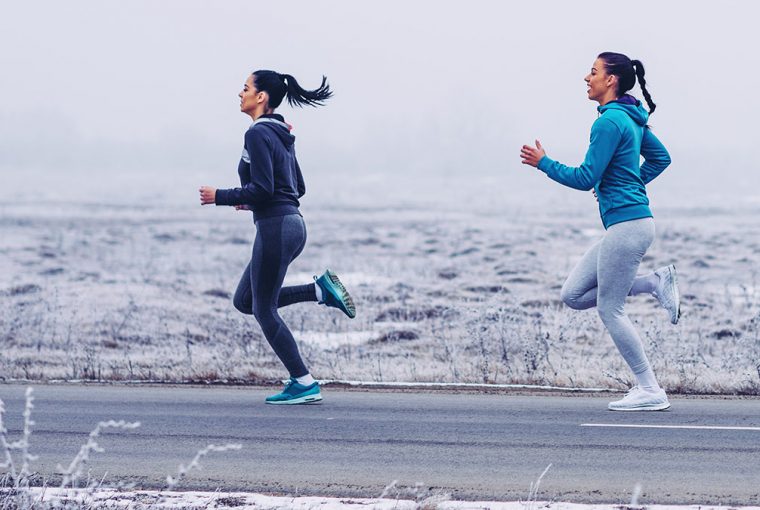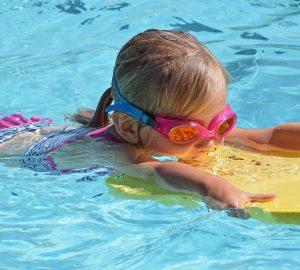Sometimes, the seasons seem to change overnight. One day, you’re ticking off miles on a brisk, 60-degree afternoon with sunshine overhead; then the next morning, the temperature dips below freezing, and your route is dusted with snow. But winter running doesn’t have to be all bad. With the right gear and mindset, you can not just continue training as usual, but you can actually crush your workouts.
Instead of turning back to the cozy comforts of home—or powering up the treadmill—use these 10 tips from cold weather pros to make the best of your winter running when the chilly weather hits.
Give Yourself a Carrot
Luring yourself out the door with the promise of a reward at the end—whether it be a catch-up with a friend or a sweet treat—works. “Set a date to meet someone for a run,” says Jean M., a reader in Colorado. “There’s no wimping out when someone is waiting.”
In January and February, the Running Room in Edmonton, Alberta, hosts the Hypothermic Half Marathon, which attracts 3,500 runners in 14 cities across Canada—even at temps as low as -40 degrees Fahrenheit. “There’s a big, free brunch afterward,” says John Stanton, the founder. “People will do anything for omelets and pancakes.” Solo? “Tell yourself that you can go back inside after five minutes if it’s really bad,” says Patti Finke, a coach in Portland, Oregon. “Usually, you stay out there.”
Wear the Right Shoes
To keep warmth in and slush out, run in shoes that have the least amount of mesh. If you have shoes with Gore-Tex uppers, all the better, says Mark Grandonico, president of the Maine Track Club in Portland. Wear socks that wick away wetness but keep your feet warm, like non-itchy SmartWool socks.
Dress Like It’s Warmer
You want to be warm without sweating so much you get a chill. “The rule of thumb is to dress as if it is 10 to 20 degrees warmer,” says Grandonico. “You should be slightly cool when you start.” Think: layers of technical fabrics to wick sweat with zippers at the neck and underarm area to vent air as you heat up. The more you run outdoors, the more you’ll learn your own preferences.
Get Lit
With limited daylight, chances are you’ll be running in the dark (Alaskans only get a few hours of dim light per day). Tall snowbanks on plowed streets make you even harder to see. Wear reflective, fluorescent gear, and don’t be shy about lighting yourself up like a Christmas tree. Adam Feerst, a coach and trail race director in Denver recommends using a headlamp or carrying a flashlight—less so you can see where you’re going and more so people can see you.
Warm Up Prerun
Move around inside enough to get the blood flowing without breaking a sweat. Run up and down your stairs, use a jump rope, or do a few yoga sun salutations. A speedy house-cleaning works, too, says D. A. Reng from Kentucky.
“The cold doesn’t feel so cold when you’re warm,” adds Laura Salmon of Akron, Ohio. If you’re meeting a group of running buddies, don’t stand around in the cold chatting before you run. “We sit in our cars,” says Feerst, “waiting for one person to get out before we all get out.”
Outsmart the Wind
Start your run into the wind and finish with it at your back, so the breeze doesn’t blast you after you’ve broken a sweat. To avoid a long, biting slog, try breaking it up: Run into the wind for about 10 minutes, turn around to run with the wind at your back for five minutes, and repeat. You can seek out man-made wind shields, too. “When we get wind, it can be like a hurricane,” says Chuck Bartlett, the team director of Seattle’s Club Northwest. “The buildings downtown block it.”
Exposed skin is especially vulnerable to chilly gusts. “I use BodyGlide on my nose and on my cheeks to prevent frostbite,” says the Canadian Stanton. If wind’s in the forecast, consider slathering up with Vaseline or opting for a face mask before heading out.
Be Flexible With Pace and Mileage
“Winter running is more about maintenance miles than speedwork,” says Feerst. In very cold weather, look for “inversions,” places that are elevated and where the air will be warmer. “Even 300 feet up, the air can be 20 degrees warmer, which makes a big difference,” says Steve Bainbridge, the trails liaison for the Fairbanks, Alaska-based Running Club North, the northernmost running club in the United States.
Bainbridge’s coldest run took place in minus 50-degree weather. “My eyelashes were freezing together,” he says. If you can’t run in the middle of the day when the temperatures are warmest, run twice a day, says Stanton, three miles in the morning and three miles in the evening: “That’s better than doing one long six-mile run where you might get very cold toward the end.”
Change Quickly Postrun
Your core body temperature drops as soon as you stop running. To avoid a lingering case of the chills, change your clothes—head to toe—as soon as you can. Women need to get out of damp sports bras quickly. Put a warm, dry beenie over wet hair. And drink something hot—a steamy beverage is great, but a hearty soup does double duty by refueling your protein and sodium stores while also warming you up.
“We go to a coffee shop after our runs and use the bathroom to change,” says Grandonico. “Then we all relax with coffee and bagels.” Driving to a run? Bring a thermos of green tea or hot chocolate in your car to savor afterward.
Run Well in Rain
Runners in Mobile, Alabama, one of the wettest cities in the United States, are always prepared for rain—more than 60 inches per year, in fact. “In my car, at all times, I have a spare pair of sneakers, a running outfit, and three beach towels,” says Allyson Lamey, a member of the Port City Pacers club.
“When it’s raining, I slip my feet into plastic baggies, then put on my running shoes,” says Darryl Dalcerri of Lompoc, California. “The baggies keep my feet dry even when I run through puddles.” If you have to dry shoes overnight, crumple up newspaper and cram it tightly into your shoes, with the insoles removed. The newspaper soaks up the moisture.
Race Someplace Warm
Having a winter race to aim for is great for keeping you motivated to train through the fall. Even better motivation? Knowing race day will be free from snow and ice. Southern summers can be brutal for runners, but during the winter, temperatures are moderate enough to go after a personal record—which is part of the reason Florida alone offers many marathons in the colder months.
Originally posted at Runners World




